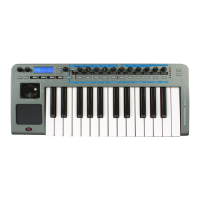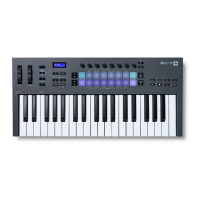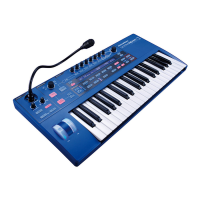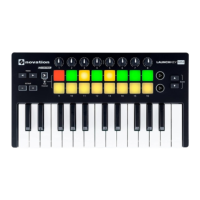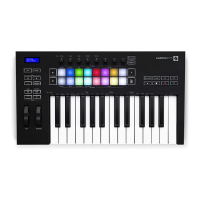Noise Waves
These have no fundamental frequency (and therefore no pitched ele-
ment). All frequencies are at the same volume. Because they have no
perceivable pitch, noise waves are often useful for creating sound effects
and percussion type sounds.
Digital Waveforms
In addition to the traditional types of Oscillator waveforms detailed
above, the KS Synth also offers carefully selected digitally sampled pre-
set waveforms containing useful harmonic elements normally difficult to
produce using traditional Oscillator waveforms.
The Mixer
To extend the range of sounds that may be reproduced, a typical
Analogue synthesizer often has more than one Oscillator. By using
more than one Oscillator when creating a sound, it possible to achieve
very interesting harmonic mixes. It is also possible to slightly detune
individual Oscillators against each other which creates a very warm ‘fat’
sound. There are has three independent Oscillators and a separate
Noise Oscillator.
Some synths such as the Novation KS 5 often have a separate Mixer
section available on the front panel. On the X-Station’s KS Synth imple-
mentation, a single LEVEL knob within the OSC / MIXER section is
used to adjust the levels of the Oscillators and Noise generator. These
may be independently adjusted and mixed together to form a new,
more harmonically complex waveform.
Use the Oscillator SELECT button to select the signal controlled by the
LEVEL knob. A column of LEDs above the button indicate which signal
is currently selected.
The Filter
The X-Stations KS Synth is an Analogue subtractive type of music syn-
thesizer. Subtractive implies that part of the sound is subtracted some-
where in the synthesis process.
The Oscillators provide the raw waveforms with plenty of harmonic con-
tent and it is the Filter that subtracts unwanted harmonics in a control-
lable manner.
Three types of Filter are available. The type of Filter most commonly
found on synthesizers is the Low Pass type. With a Low Pass Filter, a
cut-off point is chosen and any frequencies below that point are
passed. Any frequencies above are filtered out. The setting of the FRE-
QUENCY knob on the front panel dictates the point below which fre-
quencies are removed. This process of removing harmonics from the
waveforms has the effect of changing the sound’s character or timbre.
When the FREQUENCY knob is set fully clockwise, the filter is set com-
pletely open and no frequencies are removed from the raw Oscillator
waveforms.
In practice, there is a gradual reduction in the volume of the harmonics
above the cut-off point. How quickly these harmonics are reduced in
volume above the cut-off frequency is determined by the Filter’s slope.
This slope is measured in ‘volume units per octave’. Since Volume is
measured in decibels, this slope is quoted in number of decibels per
octave (dB). Typical values are 12dB or 24dB per Octave. The higher
the number, the faster the harmonics are cut and the more pronounced
the filtering effect.
The button on the section marked SLOPE allows either the 12dB or
24dB type filter slope to be selected.
A further important feature of the Filter is the RESONANCE control.
Frequencies at the cut-off point may be increased in volume by this
control. This is useful for emphasizing certain harmonics of the sound.
As the RESONANCE is increased, a whistling like quality will be intro-
duced to the sound passing through the filter. When set to very high
levels, RESONANCE actually causes the filter to self - oscillate when-
ever a signal is being passed through it. The resulting whistling tone
being produced is actually a pure sine wave, the pitch of which
depends on the setting of the FREQUENCY knob (the filter’s cut-off
point). This resonance-produced sine wave can actually be used for
some sounds as an additional sound source if desired.
SYNTHESIS TUTORIAL
The Filter
• 32 •

